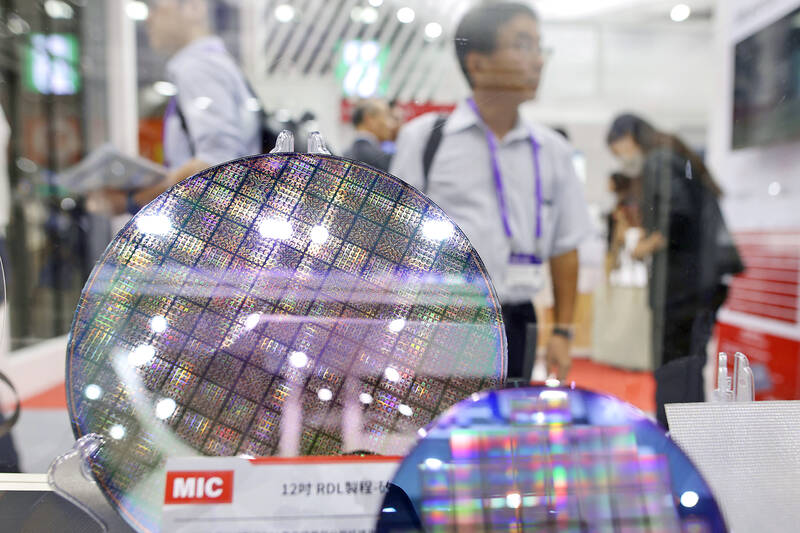Fixed asset purchases, excluding land, by the manufacturing sector in the second quarter fell 16.1 percent year-on-year to NT$450.9 billion (US$14.1 billion), following a 3.3 percent annual decline in the first quarter, the Ministry of Economic Affairs said yesterday.
On a quarterly basis, purchases decreased 3.6 percent, the ministry’s report showed.
Electronic component makers have become conservative in investment and expansion due to the weakening of end-market consumption, the ministry said, explaining the decline in purchases.

Photo: EPA
Another factor is a relatively high base of comparison during the same period last year when some manufacturers earmarked funds to install equipment, it said.
Fixed assets include machinery, equipment, buildings and construction projects, as well as furniture, fixtures and vehicles.
In the first half of the year, fixed asset purchases fell 10 percent year-on-year to NT$918.5 billion, but continued green energy construction and the implementation of investment projects by firms returning to Taiwan should boost investment momentum in the manufacturing sector, the ministry said.
However, with global economic uncertainties and a prolonged inventory adjustment, manufacturers would have to remain cautious regarding capital expenditure, it said.
The electronic components industry was the best performing industry in the April-to-June period with purchases of NT$274.5 billion in fixed assets, accounting for 60.9 percent of total purchases by local manufacturers, the report showed.
But the figure was 28.8 percent lower than a year earlier as global economy and market consumption remained weak and semiconductor companies slowed their investments, the ministry said.
The chemical materials industry was second in terms of fixed-asset purchases as firms spent NT$29.8 billion, up 12.8 percent year-on-year, the report showed.
The ministry attributed the increase in purchases to some firms expanding production lines to produce silicon wafers and related chemicals, while others continued to boost capital expenditure on projects related to energy conservation, carbon reduction and a circular economy, it added.
In third, the oil and coal production industry made NT$21.7 billion in fixed asset purchases, up 80.6 percent from a year earlier, as state-owned enterprises accelerated major development projects, the report said.
The metal products and the computer and optoelectronics industries also posted increases in fixed asset purchases in the second quarter, rising 2.9 percent and 2.5 percent respectively from a year ago, the report said.
Nonetheless, the machinery equipment and the base metal industries reported a 12.4 percent and 0.4 percent decrease in purchases each, as firms slowed down investment, the report said, adding that it was also due to a higher comparison base last year.
Separately, total revenue brought in by the manufacturing sector, including overseas production in the second quarter declined 15.7 percent annually to NT$7.35 trillion, as firms slowed their operations on the back of the sluggish end-market demand and continued inventory de-stocking in the supply chain, the ministry said.

The US dollar was trading at NT$29.7 at 10am today on the Taipei Foreign Exchange, as the New Taiwan dollar gained NT$1.364 from the previous close last week. The NT dollar continued to rise today, after surging 3.07 percent on Friday. After opening at NT$30.91, the NT dollar gained more than NT$1 in just 15 minutes, briefly passing the NT$30 mark. Before the US Department of the Treasury's semi-annual currency report came out, expectations that the NT dollar would keep rising were already building. The NT dollar on Friday closed at NT$31.064, up by NT$0.953 — a 3.07 percent single-day gain. Today,

‘SHORT TERM’: The local currency would likely remain strong in the near term, driven by anticipated US trade pressure, capital inflows and expectations of a US Fed rate cut The US dollar is expected to fall below NT$30 in the near term, as traders anticipate increased pressure from Washington for Taiwan to allow the New Taiwan dollar to appreciate, Cathay United Bank (國泰世華銀行) chief economist Lin Chi-chao (林啟超) said. Following a sharp drop in the greenback against the NT dollar on Friday, Lin told the Central News Agency that the local currency is likely to remain strong in the short term, driven in part by market psychology surrounding anticipated US policy pressure. On Friday, the US dollar fell NT$0.953, or 3.07 percent, closing at NT$31.064 — its lowest level since Jan.

Hong Kong authorities ramped up sales of the local dollar as the greenback’s slide threatened the foreign-exchange peg. The Hong Kong Monetary Authority (HKMA) sold a record HK$60.5 billion (US$7.8 billion) of the city’s currency, according to an alert sent on its Bloomberg page yesterday in Asia, after it tested the upper end of its trading band. That added to the HK$56.1 billion of sales versus the greenback since Friday. The rapid intervention signals efforts from the city’s authorities to limit the local currency’s moves within its HK$7.75 to HK$7.85 per US dollar trading band. Heavy sales of the local dollar by

The Financial Supervisory Commission (FSC) yesterday met with some of the nation’s largest insurance companies as a skyrocketing New Taiwan dollar piles pressure on their hundreds of billions of dollars in US bond investments. The commission has asked some life insurance firms, among the biggest Asian holders of US debt, to discuss how the rapidly strengthening NT dollar has impacted their operations, people familiar with the matter said. The meeting took place as the NT dollar jumped as much as 5 percent yesterday, its biggest intraday gain in more than three decades. The local currency surged as exporters rushed to